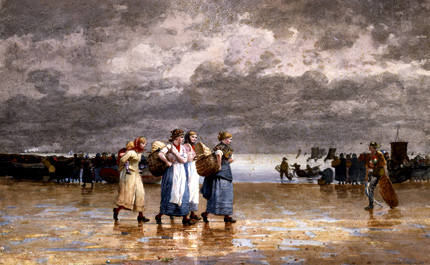
Winslow Homer's "Four Fishwives"
“American Visions: Selections from the Young Collection of American Impressionist and Realist Paintings,” opening Saturday, November 4, 2006, at the Ruth Chandler Williamson Gallery, will showcase works from eminent American artists of the late 19th century and early 20th century.
In 1946, General and Mrs. Edward Clinton Young donated an extraordinary group of American paintings to Scripps College. Among the 59 paintings in the exhibition will be works by some of the nation’s leading artists. Compelling portraits by Mary Cassatt and impressionist landscapes by Childe Hassam join powerful realist paintings by Winslow Homer and Robert Henri.
The exhibition celebrates the 60th anniversary of this major gift of an art collection that illuminates the American artistic scene at the end of the 19th and beginning of the 20th centuries. During this time of artistic change, artists moved from the French-influenced style of impressionism to an emerging American mode of realism.
In the late 1800s American artists began developing a style of Impressionism that was similar to their French predecessors. Painting mostly en plein air (outdoors) these artists sought to convey the fleeting effects of light and rendered their subjects with loose brushwork. But not simply replicating the French style, the American impressionists blended other approaches and techniques to the revolutionary artistic movement.
The American realists, who emerged around 1900, remained committed to painting modern life, but they broke away from the leisure subjects and light tones of impressionism.
Instead, they created an art of urban themes and deep tonalities, which became identified with the realist movement in the early part of the century. Several of these artists began their artistic careers as magazine and newspaper illustrators, occupations that focused them on the darker side of city life and later led critics to sarcastically dub them the Ashcan School.
The Youngs, who preferred landscape painting, did not collect the grittier views of city life; instead, they selected portraits, whose bold brushwork and dark backgrounds look back to Dutch painter Frans Hals (1582-1666) and Spanish painter Diego Velasquez (1599-1660).
Realists in the Young collection begin with Winslow Homer, one of the leading American painters of the mid-19th century, and continue with Robert Henri and George Luks, who pioneered a new realist style at the beginning of the 20th century. In his effort to directly convey a sense of emotion, Henri disdained academic painting’s emphasis on finished surfaces. “A thing that is finished is dead,” Henri said. “A thing that has the greatest expression of life itself, however roughly it may be expressed, is in reality the most finished work of art.”
The exhibition features key works from the Young Collection, including figural paintings by John La Farge, Edmund Tarbell, and Maurice Brazil Prendergast, whose moods range from mysterious to lyrical. There are also American impressionist landscapes by Childe Hassam, Willard Metcalf, Ernest Lawson, and John Twachtman, which encompass the four seasons. In addition, there are captivating portraits by such luminaries as Mary Stevenson Cassatt, the only American artist to show with the French impressionists, as well as Robert Henri and George Luks, leading figures in the Ashcan School.
General and Mrs. Edward Clinton Young became interested in the arts and humanities curriculum at Scripps through their friendship with artist Millard Sheets, the popular regionalist painter who built the art department at Scripps. General Young, who graduated from West Point in 1887, served in World War I, and retired from a business career in 1928. From 1922 to 1933, General and Mrs. Young assembled their collection of American art, and in 1940 moved from the East Coast to Sierra Madre, California.
The exhibition which will continue until December 17, 2006, was organized by Mary MacNaughton, director of the Ruth Chandler Williamson Gallery, and has been designed by Collection Manager Kirk Delman. Scripps students, Clare Heinzelman ’08 and Maggie Tokuda-Hall ’07, Wilson Interns at the Gallery, contributed interpretive texts for the exhibition.
The opening reception will be held in the Williamson Gallery, on Saturday, November 4, from 7 until 9 p.m.
The Ruth Chandler Williamson Gallery is located in Claremont, California, at Eleventh Street and Columbia Avenue, adjacent to Baxter Hall. The Gallery is open to the public, free of charge, Wednesday through Sunday, from 1-5 p.m. For more information, please contact the Gallery at (909) 607-3397.

